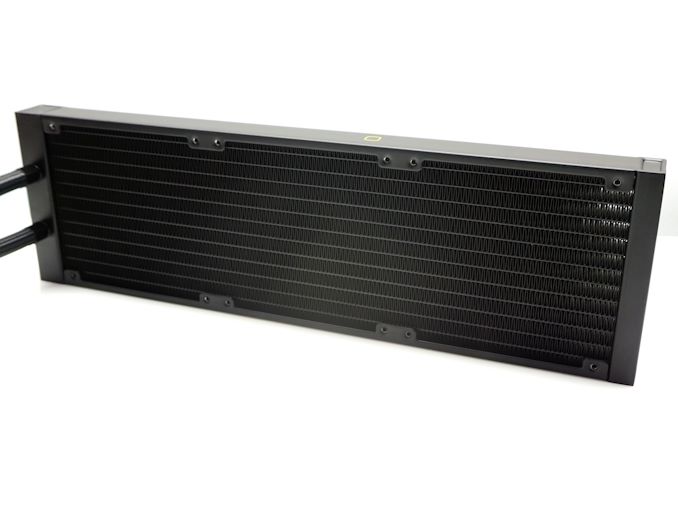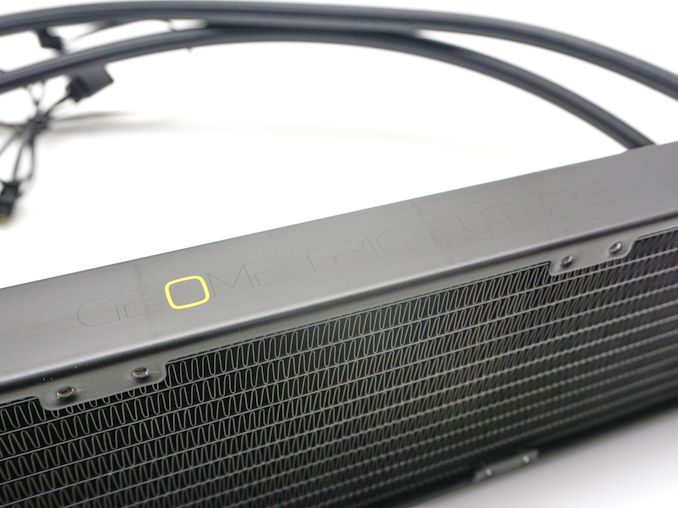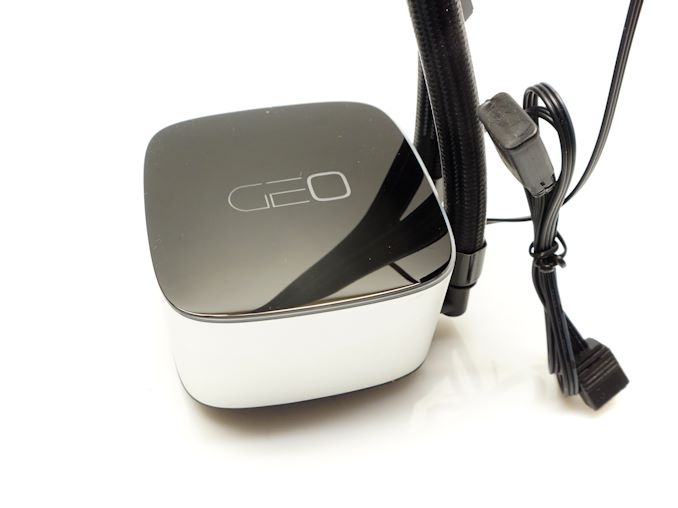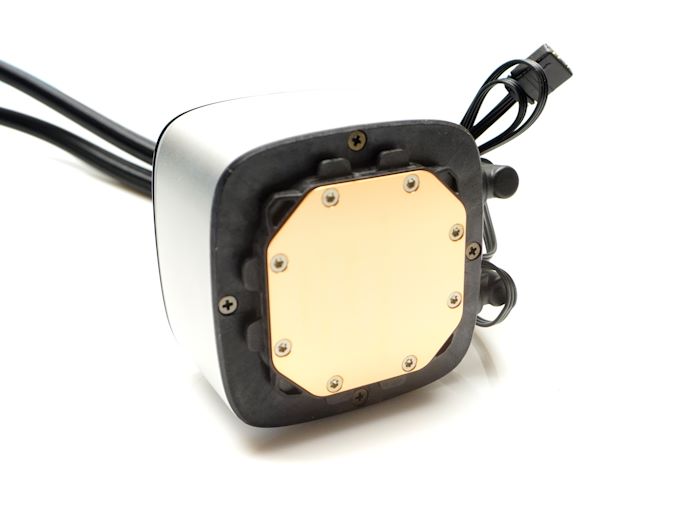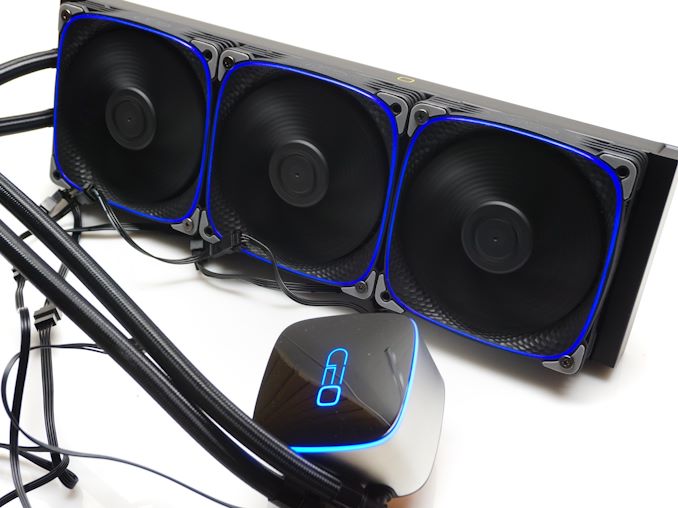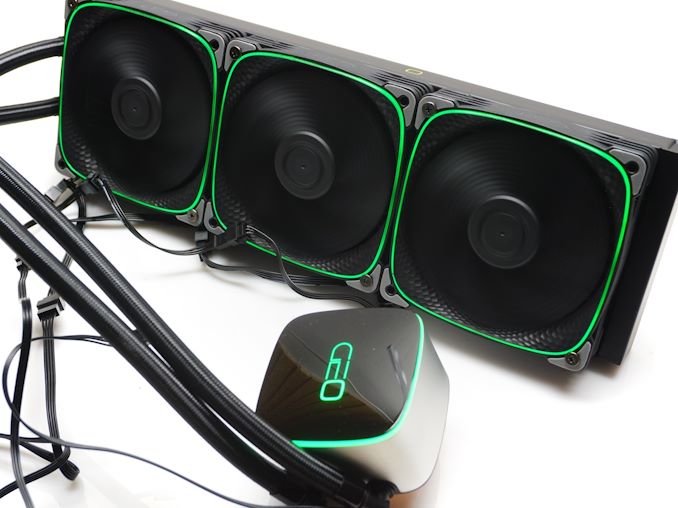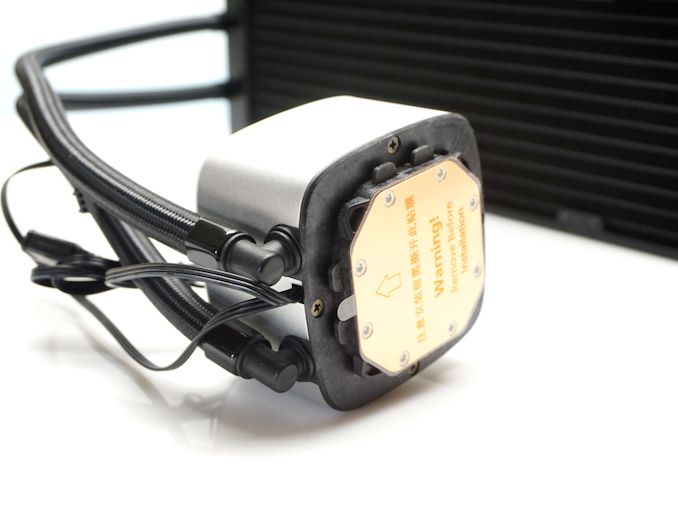
The Geometric Future Eskimo Junior 36 AIO Cooler Review: Subdued Minimalism
2024-02-08Today we’re looking at a all-in-one closed loop cooler from a face that’s new to AnandTech: Geometric Future. Founded in 2020, Geometric Future is a PC components manufacturer with a goal of setting themselves apart in the crowded PC marketplace by redefining modern aesthetics. Their approach to design emphasizes the application of geometric elements and minimalist philosophy, as reflected in their slogan, “Simplify”. They regard themselves as a potential future backbone in China’s design industry, starting with a small step in the IT sector.
For such a new company, Geometric Future has already made significant strides in the realm of PC power and cooling products. One of their most notable products – and what we’re reviewing today – is the Eskimo Junior 36, an all-in-one CPU liquid cooler available in 240mm and 360mm sizes. This cooler is designed with a minimalist aesthetic in mind, featuring a simplistic CPU block and equipped with high-performance Squama 2503 fans. Geometric Future pitches the Eskimo Junior 36 as being engineered to provide an optimal balance of cooling efficiency and aesthetics, making it able to achieve excellent cooling capabilities while maintaining low noise levels.
But marketing claims aside, we shall see where it stands in today’s highly competitive market in this review.
| Geometric Future Eskimo Junior 36 360mm AIO CPU Cooler Specifications | |||
| Type | All-in-One Liquid Cooler | ||
| Dimensions | 397 x 120 x 52 mm (radiator with fan) 78 x 78 mm (main block) 55 x 55 mm (coldplate) |
||
| Fans | 3 x 120 mm Squama 2503B FDB Fans 2000 RPM (max) |
||
| RGB | Yes (ARGB) | ||
| Supported Sockets | Intel: LGA1700 / LGA1200 / LGA115x / LGA2066 / LGA 2011
AMD: AM5 / AM4 / TR4 |
||
| Warranty | 5 Years | ||
| Price | $120 | ||
The company ships the Eskimo Junior 36 in a long and large cardboard box that hints at the dimensions of the cooler. A detailed render of the cooler itself decorates the front side of the yellow/white box, with nothing but the compatibility badges suggesting that the cooler features RGB lighting. Inside the box, the cooler is securely placed within custom-designed cardboard inserts, ensuring its protection during transit.
Geometric Future supplies only the essential parts required to use the cooler right out of the box, with no extra items or accessories supplied. The notable part here is that they provide mounting hardware for practically all currently available consumer CPU sockets, including TR4 for Threadripper 5000 processors.
At first glance, the Geometric Future Eskimo Junior 36 cooler familiarly aligns with the standard design of most 360 mm AIO coolers in the market. This cooler adheres to the typical AIO configuration, featuring a single radiator, two hoses, and a combined block that integrates a copper CPU contact plate with a compact liquid pump. Geometric Future employs black sleeved low-permeation rubber tubing, with an eye towards enhancing both flexibility and aesthetic quality. This design choice underscores Geometric Future’s commitment to blending functional cooling solutions with a sleek and more sophisticated appearance.
The substantial radiator of the Geometric Future Eskimo Junior 36 cooler, measuring 397 mm in length, necessitates a case that can house three 120 mm fans in sequence, along with adequate room for the radiator’s extra dimensions. This radiator, with a thickness of 27 mm, requires a total clearance of 55 mm when paired with fans to ensure correct installation in a system. Design-wise, it adheres to the prevalent dual pass cross-flow configuration, characterized by small fins soldered onto thin, oblong tubes. A distinctive feature of this cooler is the company logo, subtly etched across the sides of the radiator, but is nearly invisible and most likely only the yellow “O” will be visible inside a PC case.
The main block of the Geometric Future Eskimo Junior 36 AIO cooler is designed with a minimalist approach. It is a very smooth and clean solid block of metal with a high-gloss plastic top cover. 90° fittings accommodate both hoses on its side and two cables exit from the same area, one 4-pin power cable and one for the RGB lighting that can be attached either to the included controller or any other compatible RGB controller. The focus of the design appears to be on achieving a balance between functionality and a clean, understated appearance, in line with Geometric Future’s overall design ethos.
At the bottom of the main block assembly, we can see an octagonal contact plate that is attached to the plastic base cover with eight screws. Its surface is not polished down to a mirror finish but is adequately smooth and flat. The contact plate is 55×55 mm, significantly smaller than the overall 78×78 mm size of the entire block but adequate for currently available CPU dies, with the exception of the Threadripper processors that need a contact surface that is at least 70 mm long. Despite that, the Eskimo Junior 36 will still work on a Threadripper processor, just not optimally.
The three 120 mm fans supplied with the Eskimo Junior 36 probably are the highlight of the entire kit. The power and RGB cables of the fans are short, featuring both a male and a female connector. This allows multiple fans to be connected in parallel to each other (daisy-chain) and only one extension wire can be used to connect all three fans to the power and to the RGB controller. They feature a fluid bearing engine and have a maximum speed of 2000 RPM. The highlight of these fans is their scale-like “Squama” rubber surface that allegedly improves performance and reduces aerodynamic noise levels. The company’s performance specifications for the fans appear a little overconfident, especially the extremely low dB(A) rating, which would suggest that the pump is actually louder than the fan(s) and, as we will also see in the following pages, that is most definitely is not the case. These fans also feature RGB lighting, even though their all-black design conceals it even from trained PC builder eyes.
The RGB lighting of the Geometric Future Eskimo Junior 36 cooler is designed with subtlety in mind. It features a ring of RGB lighting around the top edge of the main block and on the fan frames. This design choice enhances the cooler’s visual appeal without being overly conspicuous or detracting from its minimalist aesthetic. The RGB lighting on the Eskimo Junior 36 is a fine example of Geometric Future’s commitment to combining functional performance with clean, sophisticated design elements.
Although the testing of a cooler appears to be a simple task, that could not be much further from the truth. Proper thermal testing cannot be performed with a cooler mounted on a single chip, for multiple reasons. Some of these reasons include the instability of the thermal load and the inability to fully control and or monitor it, as well as the inaccuracy of the chip-integrated sensors. It is also impossible to compare results taken on different chips, let alone entirely different systems, which is a great problem when testing computer coolers, as the hardware changes every several months. Finally, testing a cooler on a typical system prevents the tester from assessing the most vital characteristic of a cooler, its absolute thermal resistance.
The absolute thermal resistance defines the absolute performance of a heatsink by indicating the temperature rise per unit of power, in our case in degrees Celsius per Watt (°C/W). In layman’s terms, if the thermal resistance of a heatsink is known, the user can assess the highest possible temperature rise of a chip over ambient by simply multiplying the maximum thermal design power (TDP) rating of the chip with it. Extracting the absolute thermal resistance of a cooler however is no simple task, as the load has to be perfectly even, steady and variable, as the thermal resistance also varies depending on the magnitude of the thermal load. Therefore, even if it would be possible to assess the thermal resistance of a cooler while it is mounted on a working chip, it would not suffice, as a large change of the thermal load can yield much different results.

Appropriate thermal testing requires the creation of a proper testing station and the use of laboratory-grade equipment. Therefore, we created a thermal testing platform with a fully controllable thermal energy source that may be used to test any kind of cooler, regardless of its design and or compatibility. The thermal cartridge inside the core of our testing station can have its power adjusted between 60 W and 340 W, in 2 W increments (and it never throttles). Furthermore, monitoring and logging of the testing process via software minimizes the possibility of human errors during testing. A multifunction data acquisition module (DAQ) is responsible for the automatic or the manual control of the testing equipment, the acquisition of the ambient and the in-core temperatures via PT100 sensors, the logging of the test results and the mathematical extraction of performance figures.
Finally, as noise measurements are a bit tricky, their measurement is being performed manually. Fans can have significant variations in speed from their rated values, thus their actual speed during the thermal testing is being recorded via a laser tachometer. The fans (and pumps, when applicable) are being powered via an adjustable, fanless desktop DC power supply and noise measurements are being taken 1 meter away from the cooler, in a straight line ahead from its fan engine. At this point we should also note that the Decibel scale is logarithmic, which means that roughly every 3 dB(A) the sound pressure doubles. Therefore, the difference of sound pressure between 30 dB(A) and 60 dB(A) is not “twice as much” but nearly a thousand times greater. The table below should help you cross-reference our test results with real-life situations.
The noise floor of our recording equipment is 30.2-30.4 dB(A), which represents a medium-sized room without any active noise sources. All of our acoustic testing takes place during night hours, minimizing the possibility of external disruptions.
| <35dB(A) | Virtually inaudible |
| 35-38dB(A) | Very quiet (whisper-slight humming) |
| 38-40dB(A) | Quiet (relatively comfortable – humming) |
| 40-44dB(A) | Normal (humming noise, above comfortable for a large % of users) |
| 44-47dB(A)* | Loud* (strong aerodynamic noise) |
| 47-50dB(A) | Very loud (strong whining noise) |
| 50-54dB(A) | Extremely loud (painfully distracting for the vast majority of users) |
| >54dB(A) | Intolerable for home/office use, special applications only. |
*noise levels above this are not suggested for daily use
Our maximum speed testing is performed with both the fans and the pump of the kit powered via a 12V DC source. This input voltage should have the pump and fans matching the speed ratings of the manufacturer. According to the company’s specifications, the Squama fans included with the Eskimo Junior 36 should have a rotational speed of 2000 RPM. Our tachometer indicated that the fans were rotating at an average speed of 1960 RPM, very close to their rated specifications.


| Core Temperature, Constant Thermal Load (Max Fan Speed) |
The Geometric Future Eskimo Junior 36 demonstrates commendable performance across various loads, with an average thermal resistance of 0.0734 °C/W at its maximum fan speed of 1960 RPM. This figure, while slightly higher than many other 360 mm coolers, is noteworthy considering the relatively low maximum speed of the supplied fans. The cooler appears to be performing very well when the loads are high but loses ground when the load is very low.

The Eskimo Junior 36 maintains a sound pressure level (SPL) of 40.9 dB(A) at full fan speed, one of the lowest figures amongst the 360 mm AIO coolers in our database. That is not a quiet figure of course – the cooler will be clearly audible even from a distance – but we consider it tolerable for typical gaming/workstation use. 360 mm coolers typically do not run their fans at maximum speed as they can easily cope with the thermal load of CPUs without having to. It is noteworthy to mention that the pump, rated at 30 dB(A) by the manufacturer, is practically inaudible, meaning that nearly all of the noise is aerodynamic noise generated by the three cooling fans.

Using a PWM voltage regulator, we reduced the speed of the fans manually down to half their rated speed. At this setting, the 120 mm Squama fans of the Eskimo Junior 36 rotate at 1000 RPM.
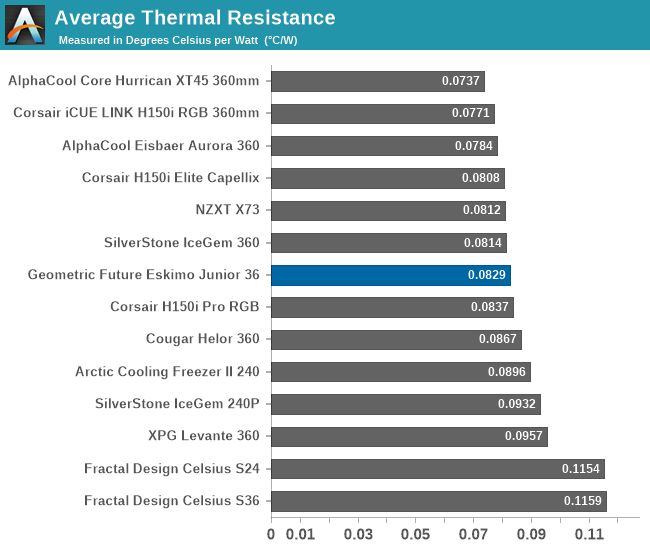

| Core Temperature, Constant Thermal Load (Low Fan Speed) |
The Geometric Future Eskimo Junior 36, when operating at half speed (1000 RPM for the fans), demonstrates fair cooling efficiency with an average thermal resistance of 0.0829 °C/W. Once again, its thermal performance is significantly improved at higher loads, with the cooler falling behind when the loads are low to very low.

The acoustic performance of the Geometric Future Eskimo Junior 36 cooler is quite good when its fans are operating at half speed. At 1000 RPM the cooler maintains a relatively low noise level of 35.2 dB(A), making it a quieter cooling solution compared to many other models that are running their fans at higher speeds.

During our thermal resistance vs. sound pressure level test, we maintain a steady 100W thermal load and assess the overall performance of the coolers by taking multiple temperature and sound pressure level readings within the operating range of the stock cooling fans. The result is a graph that depicts the absolute thermal resistance of the cooler in comparison to the noise generated. For both the sound pressure level and absolute thermal resistance readings, lower figures are better.
The Geometric Future Eskimo Junior 36, while falling slightly behind some similar designs in its category, maintains a competitive stance in the market. It offers good thermal performance that is remarkably linear and shows minimal impact from airflow changes. This performance profile indicates that the Eskimo Junior 36 is a solid choice for those prioritizing scenarios where lower fan speeds are desirable. On the other hand, its thermal performance does not improve significantly at higher airflows, limiting its maximum potential.
The Geometric Future Eskimo Junior 36 AIO Liquid Cooler, priced at $120, stands as a capable cooler within what’s already a highly-competitive market. Suitable for enthusiasts and regular users alike, the Eskimo balances price with performance and aesthetics, making it an attractive option for a wide range of builds. Its sleek design features a minimalist aesthetic and a subtle implementation of RGB lighting, offering something that, at least visually, is distinct from the many other AIO coolers on the market.
In terms of design, the Eskimo Junior 36 basically adheres to the standard AIO layout but distinguishes itself with its simplicity. The inclusion of black sleeved, flexible rubber tubing complements both its visual and functional aspects. The main block, with its sleek metal surround and subtle RGB lighting, provides a touch of elegance. The radiator is of basic design and the etched company logo on its sides is practically invisible but the Squama fan and especially the application of RGB lighting is visually outstanding.
Performance-wise, the Eskimo Junior 36 shows its strength in offering consistent cooling with minimal noise, with very good thermal performance figures at lower fan speeds. While it does not outperform most of its direct competition, its thermal performance is competitive and does manage to surpass a few rival products. While it may not significantly improve in thermal performance at higher airflows, this cooler is an ideal choice for typical users who seek effective cooling with limited noise.
At its $120 price point, the Geometric Future Eskimo Junior 36 is currently positioned as a competitive option in the mid-range cooling market. Its blend of performance, aesthetics, and affordability should make it a solid choice for a variety of PC builds. Arguably, the strongest selling point of the Eskimo Junior 36 is its outstanding aesthetics; the cooler’s understated design, coupled with its effective cooling capabilities, ensures that it not only performs well but also enhances the overall look of the system. For users seeking a fair balance between cost, performance, and aesthetics, the Eskimo Junior 36 emerges as another interesting option in the realm of AIO liquid coolers.


